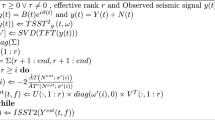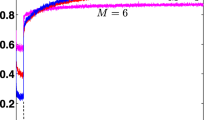Abstract
Several existing spreading sequence estimation algorithms of long code direct-sequence spread spectrum (LC-DSSS) signals require prior knowledge of the symbol duration, but research on symbol duration estimation techniques of LC-DSSS signals are rare currently. In this paper, we proposed a method of estimating symbol duration for LC-DSSS signals. On the basis of the missing data model, a set of sample covariance matrices are constructed from the received signal with a set of window durations. Subsequently, the diagonals that contain noise component are removed from the sample covariance matrices to eliminate the effects of the noise and then squared Frobenius norm is performed on the sample covariance matrices to eliminate the effects of the long code. After analyzing the second-order statistical characteristic of the squared Frobenius norm of the sample covariance matrices, a symbol duration estimator of LC-DSSS signals is derived. Numerical experiments demonstrate that the proposed estimator provides satisfactory estimation performance of the symbol duration for LC-DSSS signals at low signal-to-noise ratio, even in multiple access interference scenario and multipath fading scenario. Compared to the existing estimators, the proposed estimator exhibits superior performance.






Similar content being viewed by others
References
Bouder, C., Azou, S., & Burel, G. (2004). Performance analysis of a spreading sequence estimator for spread spectrum transmissions. Journal of the Franklin Institute, 7, 595–614.
Burel, G., & Bouder, C. (2000). Blind estimation of the pseudo-random sequence of a direct sequence spread spectrum signal. In IEEE Military Communications conference (pp. 967–970), Los Angeles.
Qiu, P. Y., Huang, Z. T., Jiang, W. L., & Zhang, C. (2008). Improved blind spreading sequence estimation algorithm for the direct sequence spread spectrum signals. IET Signal Processing, 4(2), 139–146.
Qiu, P. Y., Huang, Z. T., Jiang, W. L., & Zhang, C. (2010). Blind multiuser spreading sequences estimation algorithm for the directsequence code division multiple access signals. IET Signal Processing, 4(5), 465–487.
Zhang, H. G., Gan, L., & Liao, H. (2012). Estimating spreading waveform of long-code direct sequence spread spectrum signals at a low signal-to-noise ratio. IET Signal Processing, 6(4), 358–363.
Zhang, H. G., Wei, P., & Mou, Q. (2013). A semifefinite relaxation approach to blind despreading of long-code DS-SS signal with carrier frequency offset. IEEE Signal Processing Letters, 20(7), 705–708.
Xia, W., Zhou, Y., & Meng, Q. (2016). Run-length method for determining the segmentation length based on the segmentation long-code blind estimation. IET Signal Processing, 10(7), 732–736.
Tsatsants, M. K., & Giannakis, G. B. (1997). Blind estimation of direct sequence spread spectrum signals in multipath. IEEE Transactions on Signal Processing, 12(45), 1241–1251.
Burel, G., Bouder, C., & Berder, O. (2001). Detection of direct sequence spread spectrum transmissions without prior knowledge. In Global telecommunications conference (GLOBECOM) (pp. 236–239). TX: San Antonio.
Bao, D., Wu, R., Cai, J., & Li, P. (2013). Asymptotic distributions of estimated cyclic autocorrelations of DSSS signals and the applications. EURASIP Journal on Wireless Communications and Network, 1, 1–9.
Burel, G. (2000). Detection of spread spectrum transmissions using fluctuations of correlation estimators. In Proceedings of IEEE-ISPACS, Honolulu, Hawaii, USA.
Vlok, J. D., & Olivier, J. C. (2014). Blind sequence-length estimation of low-SNR cyclostationary sequences. IET Communications, 8(9), 1578–1588.
Xu, Z., Liu, P., & Zoltowsky, M. D. (2004). Diversity assisted channel estimation and multiuser detection for downlink CDMA with long spreading code. IEEE Transactions on Signal Processing, 52(1), 190–201.
Adams, E. R., Gouda, M., & Hill, P. C. J. (1998). Statistical techniques for blind detection and discrimination of m-sequence codes in DS/SS systems. In 5th international symposium on spread spectrum techniques and applications (pp. 853–857). Sun City.
Mou, Q., Wei, P., & Tai, H. M. (2010). Invariant detection for short-code QPSK DS-SS signals. Signal Processing, 90(5), 1720–1729.
Xu, H., Huang, Z., & Zhou, Y. (2007). Blind estimation of the symbol period of a long-code DS-SS signal. In International conference on microwave and millimeter wave technology (ICMMT) (pp. 1–4), Guilin, China.
Mou, Q., & Wei, P. (2011). Symbol duration estimation for long-code DS-SS signals under low SNR. Journal of University of Electronic Science and Technology of China, 40(3), 353–356.
Bouder, C., Azou, S., & Burel, G. (2002). A robust synchronization procedure for blind estimation of the symbol period and the timing offset in spread spectrum transmissions. In IEEE seventh international symposium on spread spectrum techniques and applications (ISSSTA) (pp. 238–241), Prague, Czech Republic.
Nzoza, C.N., Gautier, R., & Burel, G. (2004). Blind synchronization and sequences identification in CDMA transmissions. In IEEE MILCOM conference (pp. 1384–1390), Monterey, USA.
Koivisto, T., & Koivunen, V. (2007). Blind despreading of short-code DS-CDMA signals in asynchronous multi-user systems. Signal Processing, 11(87), 2560–2568.
Qiu, P. Y., Huang, Z. T., Jiang, W. L., & Zhang, C. (2010). Blind classification of the short-code and the long-code direct sequence spread spectrum signals. IET Signal Processing, 4(1), 78–88.
Hui, L., & Guanghan, X. (1996). A subspace method for signature waveform estimation in synchronous CDMA systems. IEEE Transactions on Communications, 44(10), 1346–1354.
Author information
Authors and Affiliations
Corresponding author
Additional information
Publisher's Note
Springer Nature remains neutral with regard to jurisdictional claims in published maps and institutional affiliations.
Rights and permissions
About this article
Cite this article
Huang, ZT., Liang, JH. & Wang, X. Estimating Symbol Duration of Long-Code Direct Sequence Spread Spectrum Signals at a Low Signal-to-Noise Ratio. Wireless Pers Commun 114, 1887–1904 (2020). https://doi.org/10.1007/s11277-020-07453-5
Published:
Issue Date:
DOI: https://doi.org/10.1007/s11277-020-07453-5




